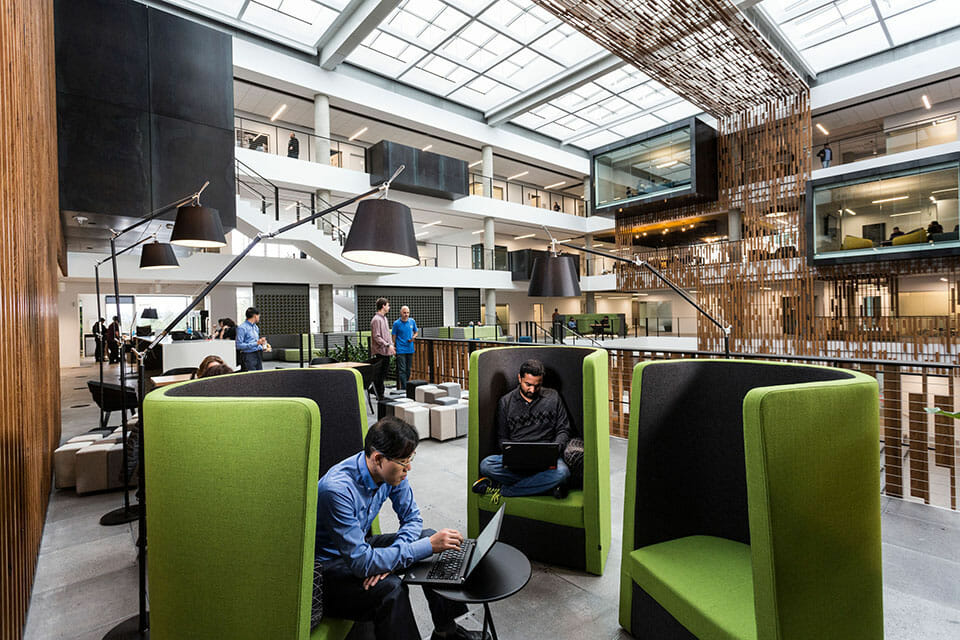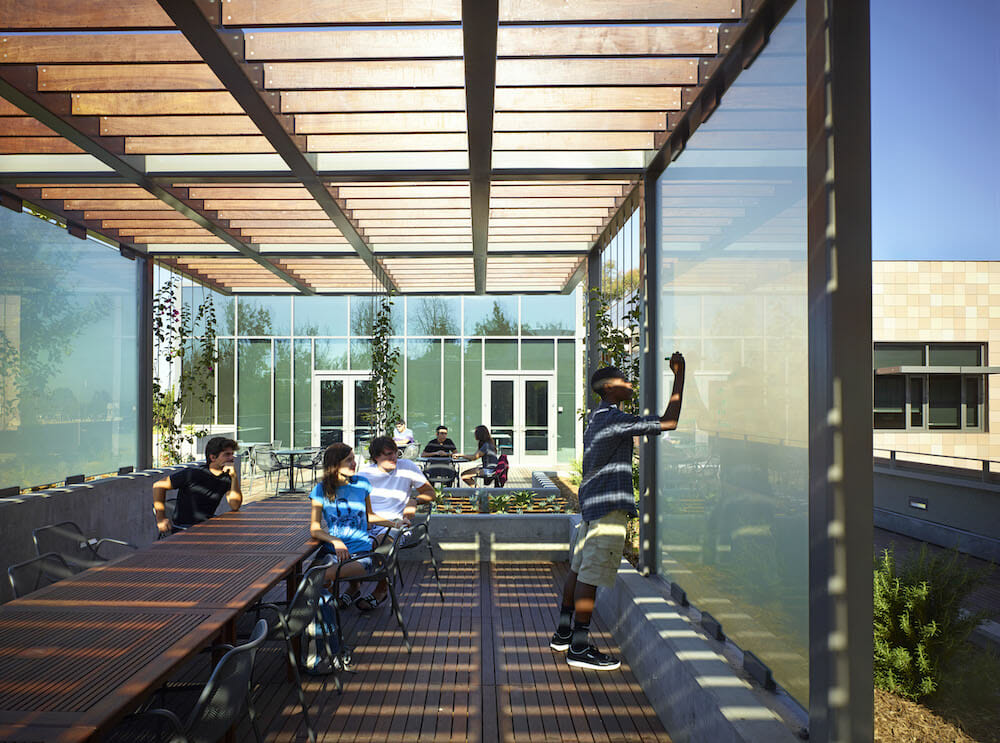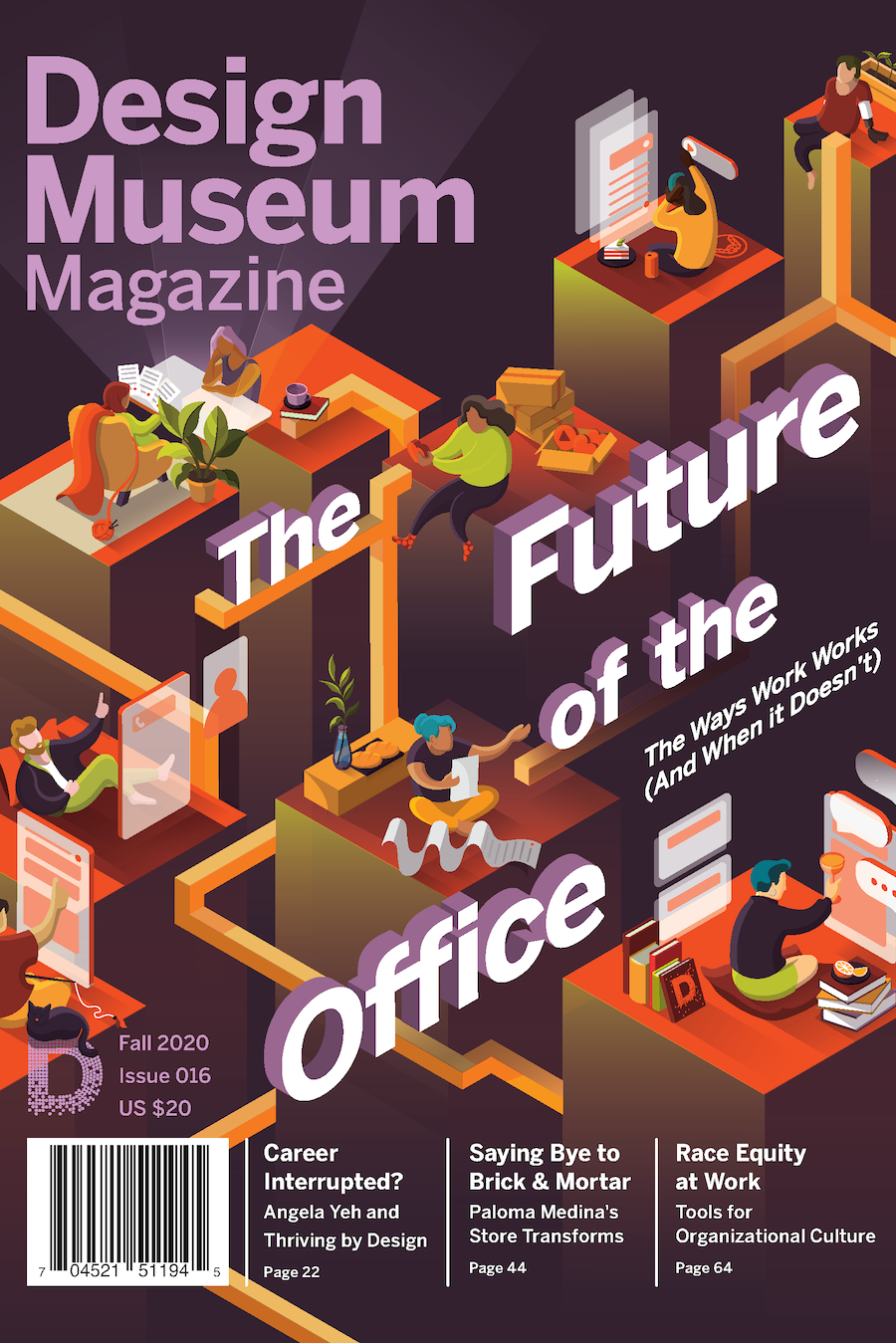The Evolving Workplace
People Will Drive the Future
COVID-19 has forever changed the workplace. The mundaneness of daily commutes, morning lattes, and conference table meetings was upended practically overnight with stay-at-home orders, makeshift workstations, and on-screen views of everyone’s very real living spaces, pets, and kids.

Photo by Brian Smale
By Michael Tingley, FAIA, Bora Architecture & Interiors
Businesses were asked to pivot on a dime to accommodate “business as usual,” as the fears and unknowns of a pandemic world swirled around us. It didn’t take long before the aspects of life that we found most ordinary, like going into the office, were the things we found ourselves missing the most.
While the pandemic is far from over, Bora, like the rest of the world, will at some point re-open. It’s not a question. We have to. But why? Haven’t we proven that we can make it working at home?
When it comes down to it, as humans we are designed for connection. It’s why the basic workplace of the past ultimately shifted outside the home into a dedicated office—because people were more productive and satisfied when working together.
So what does the workplace of the future look like, especially with the added complexity of a pandemic? Bora has focused its years of workplace design around the human experience, designing through the lenses of empowerment, well-being, and storytelling. While COVID-19 unquestionably alters the way we approach design moving forward, we believe these are still the areas to focus on. Despite the physical limitations of our current climate, we see the need to bring people together prevailing as a foundational aspect of the future workplace, whatever form it takes when we re-engage.

Photo by Brian Smale
Empowering People
In workplace design, we seek to empower users in their surroundings to enable them to do their best work. We achieve this by addressing how the individual works best and how the workplace can change to meet their needs over time. So when we think about spaces for meeting, collaborating, heads-down work, or socializing, we consider not just their individual functions, but the quality of the surrounding spaces that support their activity. Now more than ever, we are seeing several qualities that should inform our approach to workplace design:
Choice in spaces. With many companies giving employees the option to return to the office, those who are opting in are doing so because it offers something they can’t get at home. It could be social capital with co-workers, a quiet space void of kids or distractions, or a place in which teams can collaborate. As we see the co-working trend move increasingly into the company workspace in a post-COVID world, it will be more critical than ever to continue to empower the 21st-century worker with more variety in workspaces to enhance productivity. Quiet libraries, project rooms, and private huddle spaces support worker choice and provide freedom to work in a customized setting. Technological advancements allowing employees to explore how they want to work without being tethered to their desks give designers the further freedom to create “work anywhere” environments that embrace impromptu meetings, casual gatherings, and outdoor connections. We anticipate a potential decrease in dedicated workstations and more support for hot desks and touchdown stations.
Our approach to social amenities in the office is also likely to evolve. We can see the future office shifting from “workplace” to more of a “meeting house,” where employees are drawn to come together to share ideas, reinforce culture and strengthen connections. After months of isolation, more value will be found in meaningful in-person conversation than in the former amenities once intended to help employees endure long hours spent at the office (think lounges, game rooms, and snack bars).
Flexible programming. Now more than ever, the workplace program must be flexible and adaptable to accommodate employees. This was an emphasis pre-COVID, but with the immediate need for social distancing and the unknowns of the pandemic’s longer-term implications, we are taking a deeper look at the benefits of changing usage patterns and modifying occupant behavior without investing in more permanent, higher-stakes physical modifications. Easy adjustments can be made through furniture and technology reconfigurations, for example, before looking to more permanent modifications like building or removing walls.
We can also examine opportunities for temporary expansion; typical spaces for gathering could be good candidates for change. A corporate dining facility or training room could be converted into properly distanced workspaces for employees to offset capacity reductions elsewhere. Or covered outdoor spaces, where the air is safer and healthier, could potentially be repurposed to meet staffing needs. Thoughtfully developing these strategies will also provide employers with a contingency plan for future crises.
Technology. Along with floor plan flexibility, the post-COVID workplace must have the technology to bridge two active work environments simultaneously—the traditional office and the home office. While virtual conference software like Zoom has now become a constant entity in our work and social lives, how will this shape the future? How can we fuse in-person work with work-at-home technology, still ensuring that all are “in the room” together?
We anticipate an increase in virtual tools that facilitate these activities, such as the visual collaborative platform Miro, or virtual reality options which can allow people to “collaborate in shared space” while working remotely. Such tools could also be a case for reduced work travel, making us think twice about spending two days of flight time for a two-hour, in-person meeting.
We will need to be both equipped and nimble to ensure that the workplace is remote-enabled and adaptable for seamless collaboration. With these systems in place, the new workplace will be able to adapt quickly, with resilience in the face of future crises.
Social Justice and Equity. At Bora we believe the spaces we create must be welcoming, safe, and inclusive, which requires a deep understanding of the systems that have resulted in racism and injustice. To deliver on this commitment, we recognize the need to expand our thinking about what constitutes “good design,” and have adopted Critical Race Theory as the lens through which we approach our work.
This is central to how we see the workplace of the future. Creating a work environment that respects and reflects the diverse experiences of its occupants is critical to designing for social justice, and that is why we chose to become a JUST-certified firm. But, so is a design process that responds to the voices of the neighborhoods we build in and prioritizes care for historically under-represented and marginalized communities.
We also consider whether the workplace is equitable for all employees. When the pandemic forced us all to work from home, the push was to make sure everyone had proper and equal access to the technology, software, tools, resources, and office ergonomics needed to do their work. In doing so, we actually discovered inequities with our younger staff that had not been considered in depth before.
For example, many felt isolated and challenged in less-than-ideal work-from-home settings. Many live on their own, with limited to no peer interaction, while others struggle to work efficiently while cohabiting with multiple housemates. Not being in the office eliminates in-person mentorship opportunities and impromptu social interactions, values that contribute significantly to a young person starting in their career. We are engaging ongoing dialogue about how we can better support our 20-somethings in these areas.
As we consider our eventual transition back into the office, we know we will be returning changed, and with many questions. Should employers have incentives to help support workers who need a better work-from-home environment? How can we ensure employee needs are being met equitably, regardless of where they are working? How can our younger staff still benefit from in-office mentorship if working from home? Should we consider great subsidies for technology, equipment, or transportation costs?
With the future workplace likely to be a hybrid of working from home and working on site for many, along with the fact that the workforce will forever be a diversity of ages, genders, races, and lifestyles, it is truly to the benefit of all that we champion equitable environments with the tools to support everyone.

01 Social Justice & Equity JUST certification is like a nutrition label for equitable organizations based on policy transparency
02 Technology = Work From Anywhere The advancement of technology allows work to happen in unexpected locations
03 Flexible Programming Work happens in a variety of settings over the course of the day, requiring flexible options
04 Choices in Spaces Different work is served by different settings; providing choice is the key
Prioritizing Wellness
As we design for a post-pandemic future, health and wellness are vital considerations for the workplace. We ensure employees’ physical, mental, and emotional health in the workplace by prioritizing sustainability and biophilic measures to promote the well-being of humans and the environment.
Health and well-being. Ample access to daylight, nature, and fresh air are shown to improve overall health and boost work productivity. Designing environments that provide all employees with access to these natural amenities will be key to creating healthy outcomes, and giving them a choice in how they interact with them over the course of a day can further enhance the benefit. Integrating plant life, using naturally occurring materials such as wood and stone, and reflecting natural systems will improve the quality of the work environment, thereby reducing stress and anxiety. Gentle fans that circulate air and mimic breezes, lighting systems that reflect circadian rhythms, operable windows, views and access to nature—these are all healthy strategies likely to show up in increasing amounts in the next generation of offices.
We also envision outdoor work settings becoming a more integral part of a healthy work environment, with shade, technology, and other support systems that facilitate this end. For Microsoft’s headquarters in Redmond, WA, for example, we looked beyond the building footprint to make use of unconventional spaces, designing three freestanding meeting “pods” that open fully to fresh air while activating an unused concrete office plaza. We imagine settings like this will become a more commonplace part of the workplace in the future.
Encouraging movement. Creating a work environment that encourages movement will be a new standard for health. This could come through strategies such as open stairs positioned in a more convenient place, adjustable-height desks and meeting tables that encourage standing, or the distribution of amenities and varied work settings across the floor plan to encourage movement throughout the day. Even “walking meetings,” which many of us have been experimenting with recently, could become a more integral aspect of work in the post-COVID workplace.
Material safety. The materials we employ in the construction of the workplace can have profound impacts on our well-being. The contents of these materials can result in exposure of chemicals into the environment, directly creating health challenges for employees. Beyond the impact within the workplace, the production processes for many common materials create toxic waste that are poisonous for our planet and its inhabitants. Sourcing this type of information is often difficult or impossible and has warranted our involvement in the Healthy Product Declaration (HPD) Collaborative, which is a standard specification, composed of a format and instructions, for the accurate, reliable, and consistent reporting of built-environment product contents and their associated health information. Additionally, all selected materials should have the resilience to withstand constant cleaning.
Touchless technology. With social distancing and hygienic fastidiousness at a new level, we realize that the less contact there is with shared materials, the better. Automated systems and touchless technology can be applied to elevators, doors, faucets, and fixtures, and despite their higher cost, are likely to be highly preferred moving forward in the name of health and sanitation.

01 Encouraging Movement Light-filled, easy-to-find stairs encourages their use, promoting health and social interaction
02 Material Safety Knowing the source and contents of the products in our environment, we can confirm they are safe
03 Health & Well-Being Biophilic Principles, along with natural light and materials, create a healthy work environment
04 Touchless Technology Allows us to engage with our environment while maintaining sanitary conditions
Connecting Through Story
Storytelling is a critical part of the workplace, emphasizing the connection of people to their workplace. It makes work meaningful, reinforces that workers are a part of a bigger movement, and reminds them why they choose their company day after day.
As careful listeners who seek out the big stories behind a company’s brand and culture, we integrate a client’s spirit into design in a meaningful way. Material selections, assembly details, lighting, and even space planning are a medium for bringing each client’s unique story to life and infusing joy into the daily experience of work. For us, this has meant creating travel- based conference rooms for a hospitality client, sports-themed environmental graphics for an athletic giant, and modernized wall patterns honoring the history of a beloved city landmark.
Visual cues will continue to be critically important to people’s experiences in the office. We are visual learners, and the visuals we implement— through art installations, signage, or environmental graphics—are dynamic tools to reflect brand. They also serve to educate, with signage being an effective way to put building function and high-performance features on display to users.
COVID is now a part of our story, and as employees return to work, they will be looking for reassurance about their safety and the values of their workplace. Employers can use this opportunity to educate about said values, about building performance features, and about the evolving culture and behaviors that convey employee health and wellness.
Through wayfinding, graphics, physical indicators, and visual cues, safety communication surrounding a return to the office will help minimize stress and anxiety. Strategies may include implementing a one-way circulation path to minimize interactions in spaces where proper distancing can’t be maintained. Specific doors could be designated for entering and others for exiting, both at the outdoor access point and at key places within the office. Narrow stairways could be specified for movement in one direction at designated times of the day. With many changes and operational adjustments ahead, highlighting policy revisions can help employees navigate the new realities.
The stories we tell are a reflection of our world, our communities, and our mission in these places. People will ultimately be drawn to the workplace for their human element— the extent to which they can feel connected in a meaningful way. As corporations grow and automation thrives, and as we experience increased vulnerability to global and environmental crises, we believe the nuances afforded by storytelling will be all the more needed in the workplace to remind us of our humanity.

People will ultimately be drawn to the workplace for their human element—the extent to which they can feel connected in a meaningful way.
Photo by John Linden
People Will Shape the Future
The workplace of the future is multi-faceted, building on much of what we have already established but also with a greater emphasis on flexibility, equity, wellness, and the human story. At the end of the day, it’s still about the people and optimizing their environment, so they can come together, not stay apart.
Our changed COVID world will cause us to re-evaluate and rethink our operational models. Challenges and preconceptions are a large part of the pivot we all need to consider. Can we reduce the number of hours everyone is needed on site? Will we actually need to accommodate fewer people in the workplace on any given day, thereby reducing the amount of space we need to accommodate them? Should we expand the definition of the workday and consider shifts or alternate days, augmenting the gaps with virtual engagement?
There are many questions still unanswered, and let’s face it, we may never return to the prior model of fully working in the office. But while the unknown can drive us to fear, it can also have the opposite effect, fueling our determination to be better and inspiring our hope for change. By prioritizing people and their health, wellness, and satisfaction, we are investing in the latter and remain optimistic that these motivations are what will continue to bring us together to innovate the ever-evolving workplace.
From Design Museum Magazine Issue 016
